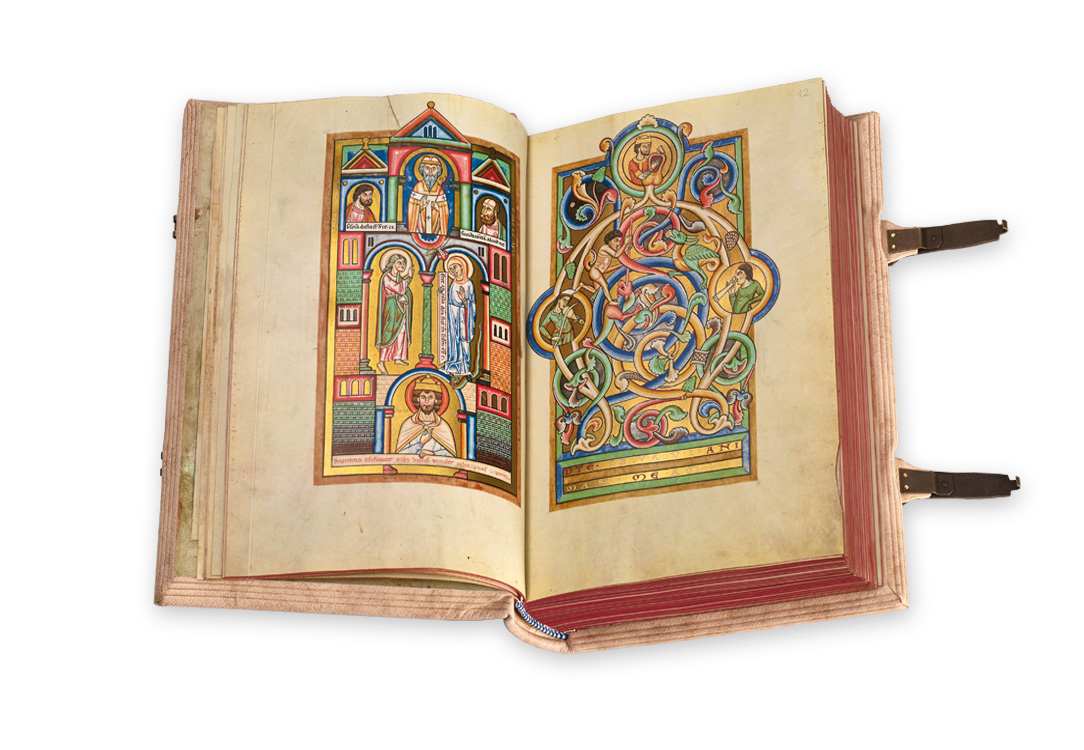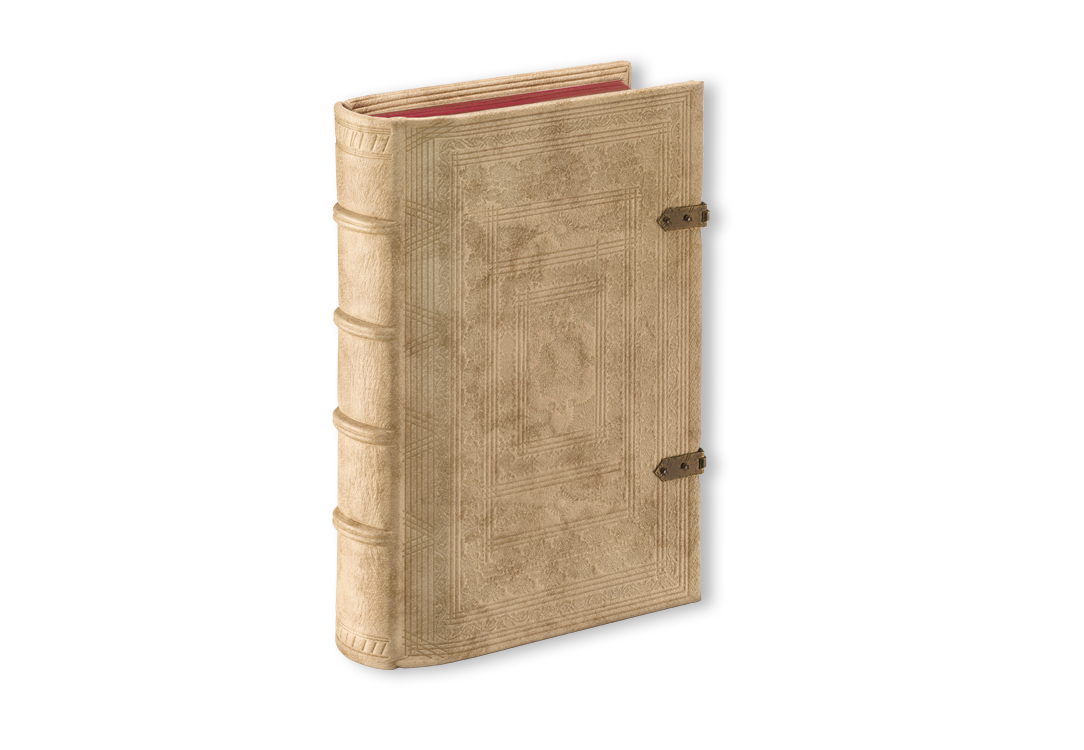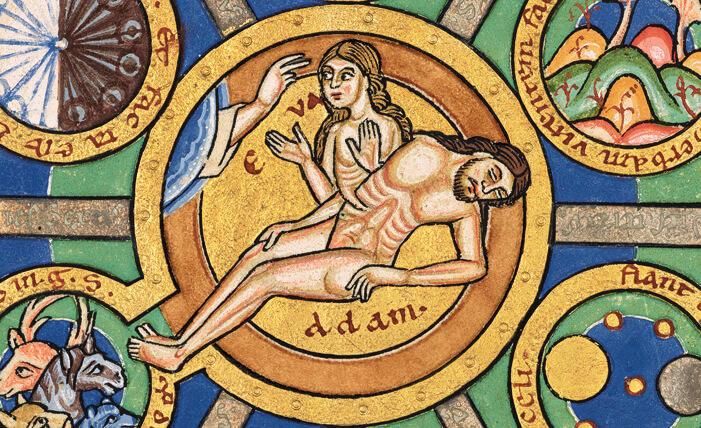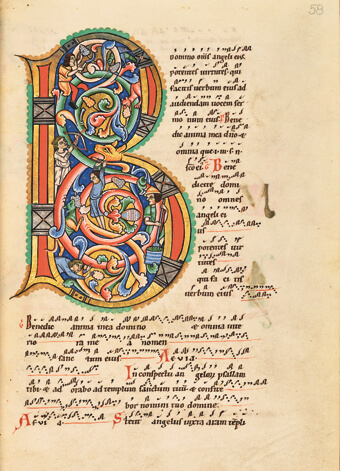
The Stammheim Missal
The Most Beautiful Illuminated Manuscript of the German Romanesque
The Stammheim Missal leaves one speechless from respect and astonishment. A true culmination of the Romanesque from the final third of the twelfth century. Flawlessly beautiful, pure and clear, perfect in its artistic execution. It features depictions of a high quality found in no other manuscript. In addition to scenes from the Old Testament, they illustrate the major events from the life of Jesus and the festivals of the saints especially honoured in the liturgy. Its calendar is unusual and unique, with its framing architectural and depictions of the hours of the day and night in a gold-bordered disk. In short, a manuscript of superlatives, which after 850 years still radiates as brightly as did at the time it was created.
Stammheim Missal
The Stammheim Missal: The Manuscript
The Romanesque Art Perfected
The Stammheim Missal was produced around 1170 in St Michael’s Benedictine monastery at Hildesheim. On the highest artistic and theological level, it represents Romanesque manuscript illumination in its purest form. The perfectly executed miniatures are breathtakingly beautiful. The impression of colour they convey recalls the masterpieces of enamel art from this period. The generous gold grounds; the geometric ornamental frames, which permit a number of image fields in a deliberately cruciform arrangement; and the symmetrical pictorial structure lend majesty to the miniatures. The rigor is lightened by the postures, gestures, and gazes of the figures, which seem alive and dynamic as a result.
Manuscript for Canonization
The Stammheim Missal is a missal in the sense that it contains all the vocal music, prayers and scripture readings used over the course of the church year to celebrate the mass at St Michael’s. Nevertheless, it has its own structure that is clearly not intended for liturgical use but should rather be understood as a kind of shrine, in which the elements of the liturgy of the mass are recorded and adorned in the most splendid possible way. The Stammheim Missal was primarily created in memory of Bishop Bernward of Hildesheim (died 1022), the founder of the monastery, and served to support the process of his canonization in 1193. Accordingly, the veneration of Bernward plays a prominent role in the manuscript.
As if Fresh from the Scriptorium
The Stammheim Missal seems flawless. Gold and colours radiate on the bright parchment with incomparable freshness and purity. Eight and a half centuries have left behind almost no traces of aging. Its three owners have preserved the manuscript with great care and respect over the course of history. From the twelfth century until 1803, the monks of St Michael’s guarded this treasure of a book. In the wake of secularization, the last Prince-Bishop of Hildesheim, Franz Egon, Baron of Fürstenberg, took charge of it. Until the twentieth century, the missal remained in Stammheim Castle in Cologne, which belonged to his family. Finally, in 1997 it was purchased by the J. Paul Getty Museum through the mediation of the antiquarian → Dr. Jörn Günther.

Stammheim Missal
Under the Magnifying Glass: Artistic Perfection in Every Initial
The Stammheim Missal is fascinating not only for the perfection of its miniatures, above all terms of their symmetry, colour and form in the spirit of Romanesque art, but also for a number of elaborately decorated initials. The larger initials, at a height of five to eighteen lines, can be divided into historiated, inhabited and decorated initials. The historiated initials contain figural scenes related to a text. The inhabited ones, by contrast, feature people, animals and mythical beasts that quite specifically use the volume of the letter as a support surface, or the life. The motifs of the ornamented initials are purely decorative and get by without any figural elements. The simplest of them are geometrical designs.
The largest inhabited initial in the Stammheim Missal is on fol. 58r. It opens the choral music for the Feast of St Michael, the patron saint of the monastery. In the vines decorating the interior fields of the letter B, which emerges from the mouth of a dragon, one discovers various figures working on harvesting grapes and producing wine. At the very top one sees a man harvesting a grape with a sickle. In the bottom bulge of the B, a man is picking a grape by hand. In the center, two others threaten—with a bow and arrow and a club, respectively—animals and birds that are nibbling at the grapes. At bottom right, finally, a man with a long-handled spoon appears, which he is dipping into a vat full of grapes.
Stammheim Missale
Stammheim Missal: The Edition

Manuscript and Facsimile in Overview
The Stammheim Missal is the most beautiful illuminated manuscript of the German Romanesque. This facsimile edition reproduces the splendour of this extraordinary manuscript in all its perfection, taking away the viewer’s breath with rapture and astonishment.
Manuscript: Los Angeles, The J. Paul Getty Museum, Ms. 64
Date of Origin: ca. 1170
Place of Origin: Hildesheim, St Michael’s Benedictine Monastery
Dimensions: 28,5 x 18,5 cm
Extent: 370 pages (184 folios)
Artists: probably just one manuscript illuminator for the miniatures and the larger initials, four scribes for the text, all from St Michael’s
Patron: St Michael’s at Hildesheim
Illumination: twelve full-page miniatures, three richly decorated incipits, two half-page decorative initials, twenty-nine pages with architectural frames, thirty-seven large and hundreds of smaller initials in gold, twelve calendar pages with illuminations, glimmering gold on all pages, shining silver, intensely brilliant colours
Binding: bright leather binding with rich blind embossing and brass clasps
Commentary Volume for the Facsimile Edition by Elizabeth Teviotdale / Christine Sciacca / Nancy Turner / Kristen Collins / Gerhard Lutz
Print Run: 480 copies
The facsimile edition has been published under the great patronage of His Excellency, the Most Reverend Bishop Dr Heiner Wilmer SCJ, Bishop of Hildesheim.
The facsimile edition will be published in the spring of 2020.
Stammheim Missal
Enjoy Viewing 10 Sample Pages:
A Glance at the Facsimile Manuscript
The excerpt from the Stammheim Missal reproduced here shows folios 114r-118v.
Pages of text with smaller gold and coloured initials of elaborate and imaginative design (fols. 114r, 116r-v, 118r-v); two full-page miniatures for Ascension Day and the Pentecost, respectively; two larger decorative initials, C and D, which illustrate in a particularly beautiful way the interplay of gold and silver (fols. 114v, 117r).
Stammheim Missal
A Challenging Production: fac simile
The Brilliance of Precious Metals
The Stammheim Missal is splendidly decorated with gold and silver. These metals radiate their noble brilliance on nearly every page. It is particularly remarkable that even over the course of eight and a half centuries few of the silver areas have oxidized and hence turned darker. Glittering gold and gleaming silver are often directly side by side or transition into each other. Reproducing that exactly in the facsimile represents a great challenge for the experts. The transitions and variations must be exactly right at every small place. This makes not only comparing the proofs to the original indispensable but also a trained eye.
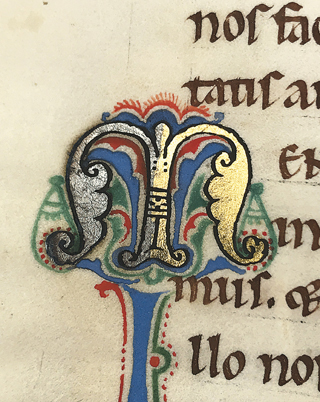
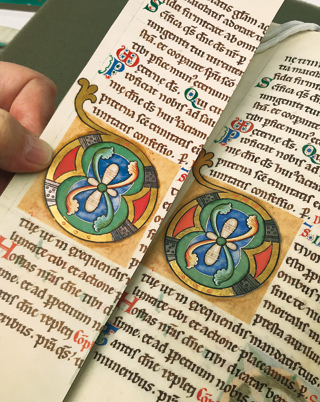
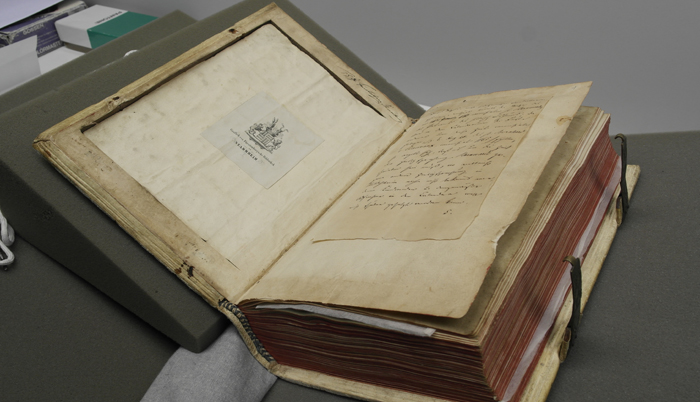
The Secret of the Front Cover
The Stammheim Missal conceals a secret in its front cover. When it is opened, an indentation of ca. 8 mm is visible. Until 1904, it held two ivory tablets, probably dating from the tenth century, which were perhaps part of the original binding of the manuscript. The diptych was then acquired by the Staatliche Museen zu Berlin, where at the end of the Second World War it burned up, apart from tiny remnants.
In close cooperation with the J. Paul Getty Museum, the publishing house and the bookbinder, a solution was worked out to fill this indentation for the facsimile edition by introducing a small, secret compartment into it.
Stammheim Missal
The Facsimile Folder for the Edition

The handbound folder for the Stammheim Missal contains four original pages from the facsimile as a double-page spread. On fol. 117r, it shows a large inhabited D initial with animals, mythical beasts and figures among the vines; on fol. 117v, a full-page miniature for the Pentecost; and, finally, on fols. 118r-v, two text pages with sixteen smaller initials in gold and colour. These examples give you an impression of the high artistic quality of the manuscript.
The associated documentation volume includes a sixteen-page introduction to the manuscript, the period of its origin and the flowering of Romanesque art in Hildesheim. In addition, the various steps of producing the facsimile are explained, which for the Stammheim Missal as well demanded great knowledge, experience and an eagerness to experiment.
Stammheim Missal
Order facsimile folder
Click here to go to the online shop (only available in German) where you can order the facsimile folder for the Stammheim Missal edition. Or send us an email to info@quaternio.ch.
Request brochure
We would be glad to provide you with additional information regarding the fine art facsimile edition of the Stammheim Missal. Click here to order the brochure.




